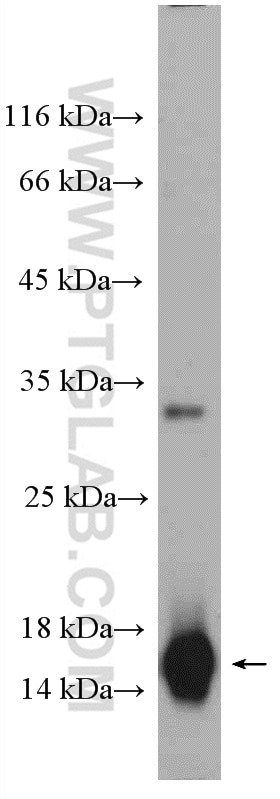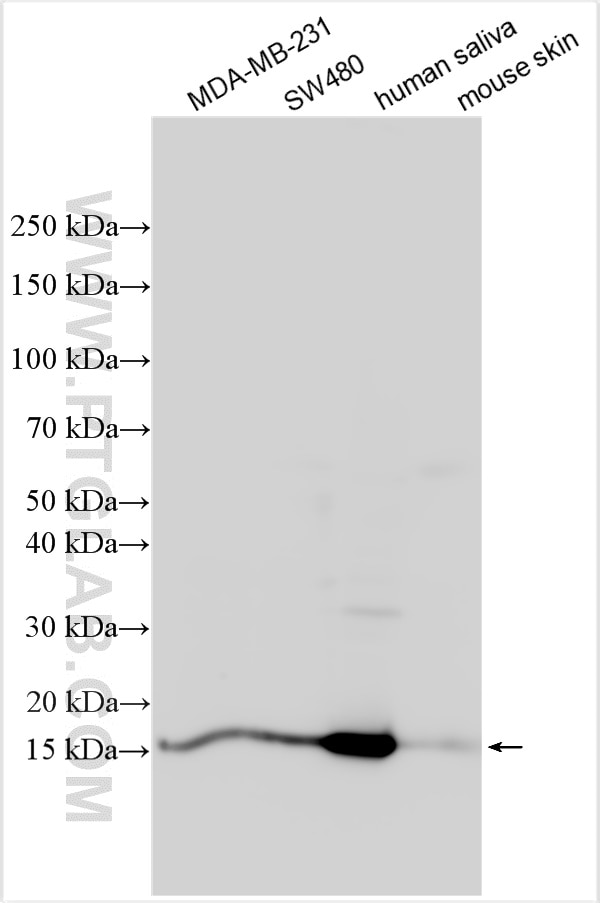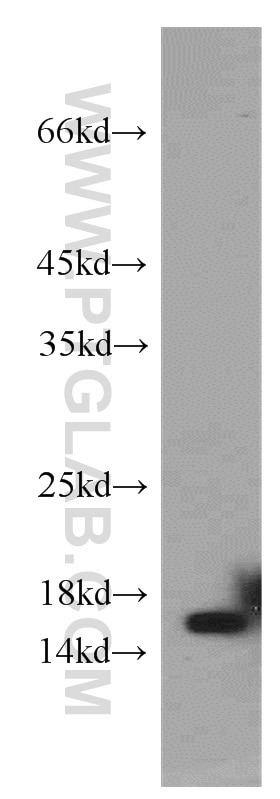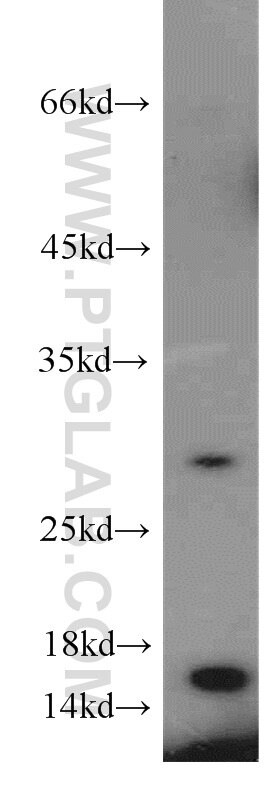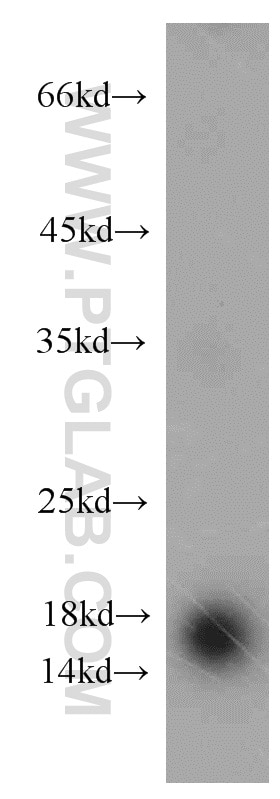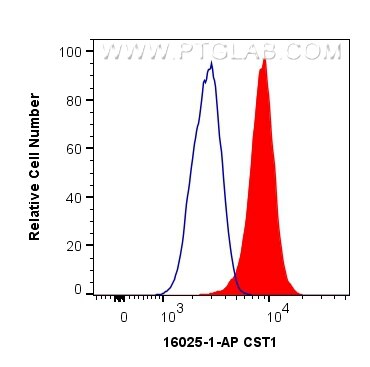- Phare
- Validé par KD/KO
Anticorps Polyclonal de lapin anti-Cystatin SN/CST1
Cystatin SN/CST1 Polyclonal Antibody for WB, FC (Intra), ELISA
Hôte / Isotype
Lapin / IgG
Réactivité testée
Humain, souris et plus (1)
Applications
WB, IHC, IF, FC (Intra), IP, CoIP, ChIP, ELISA
Conjugaison
Non conjugué
N° de cat : 16025-1-AP
Synonymes
Galerie de données de validation
Applications testées
| Résultats positifs en WB | cellules MDA-MB-231, cellules COLO 320, cellules SW480, salive humain, salive humaine, tissu cutané de souris, tissu de glande surrénale humain, tissu testiculaire humain |
| Résultats positifs en FC (Intra) | cellules MCF-7 |
Dilution recommandée
| Application | Dilution |
|---|---|
| Western Blot (WB) | WB : 1:1000-1:8000 |
| Flow Cytometry (FC) (INTRA) | FC (INTRA) : 0.40 ug per 10^6 cells in a 100 µl suspension |
| It is recommended that this reagent should be titrated in each testing system to obtain optimal results. | |
| Sample-dependent, check data in validation data gallery | |
Informations sur le produit
16025-1-AP cible Cystatin SN/CST1 dans les applications de WB, IHC, IF, FC (Intra), IP, CoIP, ChIP, ELISA et montre une réactivité avec des échantillons Humain, souris
| Réactivité | Humain, souris |
| Réactivité citée | rat, Humain |
| Hôte / Isotype | Lapin / IgG |
| Clonalité | Polyclonal |
| Type | Anticorps |
| Immunogène | Cystatin SN/CST1 Protéine recombinante Ag8862 |
| Nom complet | cystatin SN |
| Masse moléculaire calculée | 141 aa, 16 kDa |
| Poids moléculaire observé | 14-16 kDa |
| Numéro d’acquisition GenBank | BC021225 |
| Symbole du gène | CST1 |
| Identification du gène (NCBI) | 1469 |
| Conjugaison | Non conjugué |
| Forme | Liquide |
| Méthode de purification | Purification par affinité contre l'antigène |
| Tampon de stockage | PBS with 0.02% sodium azide and 50% glycerol |
| Conditions de stockage | Stocker à -20°C. Stable pendant un an après l'expédition. L'aliquotage n'est pas nécessaire pour le stockage à -20oC Les 20ul contiennent 0,1% de BSA. |
Informations générales
CST1, or cystatin SN, is a gene in humans that encodes a secreted protein belonging to the type 2 cystatin superfamily, which includes CST1, CST2, CST3, CST4, and CST5. These proteins are cysteine proteinase inhibitors found in various human fluids and secretions, where they appear to provide protective functions. CST1 is specifically found in saliva, tears, urine, and seminal fluid, and it plays a role in inhibiting the activity of cysteine proteases. CST1 has been implicated in various pathological processes, including tumor invasion and metastasis. Overexpression of CST1 has been observed in several types of cancer, such as lung, breast, colorectal, and gastric cancer, suggesting its role in the proliferation, invasion, and metastasis of these tumors.
Protocole
| Product Specific Protocols | |
|---|---|
| WB protocol for Cystatin SN/CST1 antibody 16025-1-AP | Download protocol |
| FC protocol for Cystatin SN/CST1 antibody 16025-1-AP | Download protocol |
| Standard Protocols | |
|---|---|
| Click here to view our Standard Protocols |
Publications
| Species | Application | Title |
|---|---|---|
Cell Rep Med Personalized drug screening in patient-derived organoids of biliary tract cancer and its clinical application | ||
Nat Commun Integrated single-cell transcriptome analysis reveals heterogeneity of esophageal squamous cell carcinoma microenvironment. | ||
Cell Res Differential secretome analysis reveals CST6 as a suppressor of breast cancer bone metastasis. | ||
Oncogene CST1 inhibits ferroptosis and promotes gastric cancer metastasis by regulating GPX4 protein stability via OTUB1
| ||
Mol Oncol Cancer-associated fibroblasts educate normal fibroblasts to facilitate cancer cell spreading and T cell suppression. | ||
Aging (Albany NY) Transcriptional dysregulation of TRIM29 promotes colorectal cancer carcinogenesis via pyruvate kinase-mediated glucose metabolism. |
